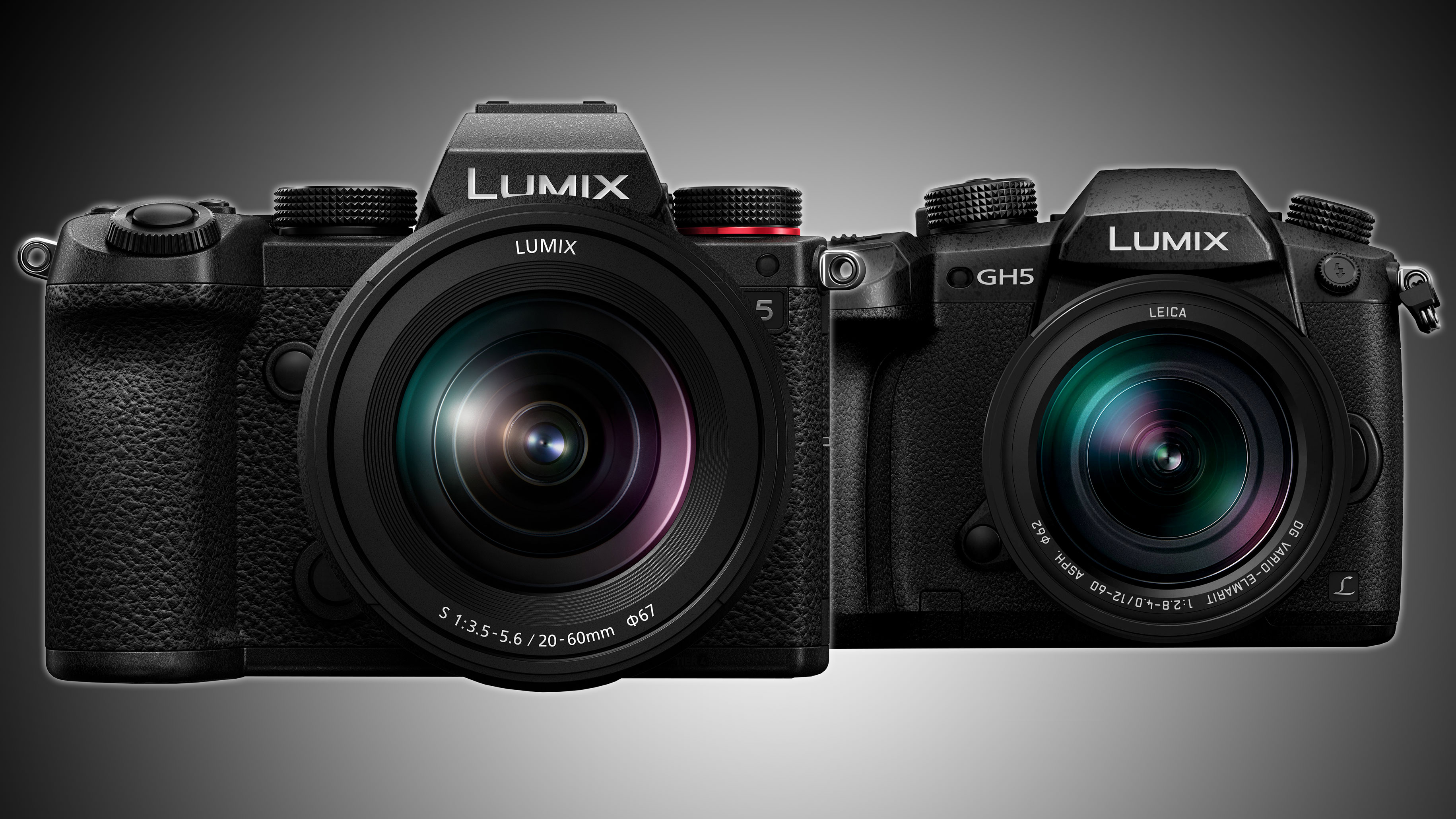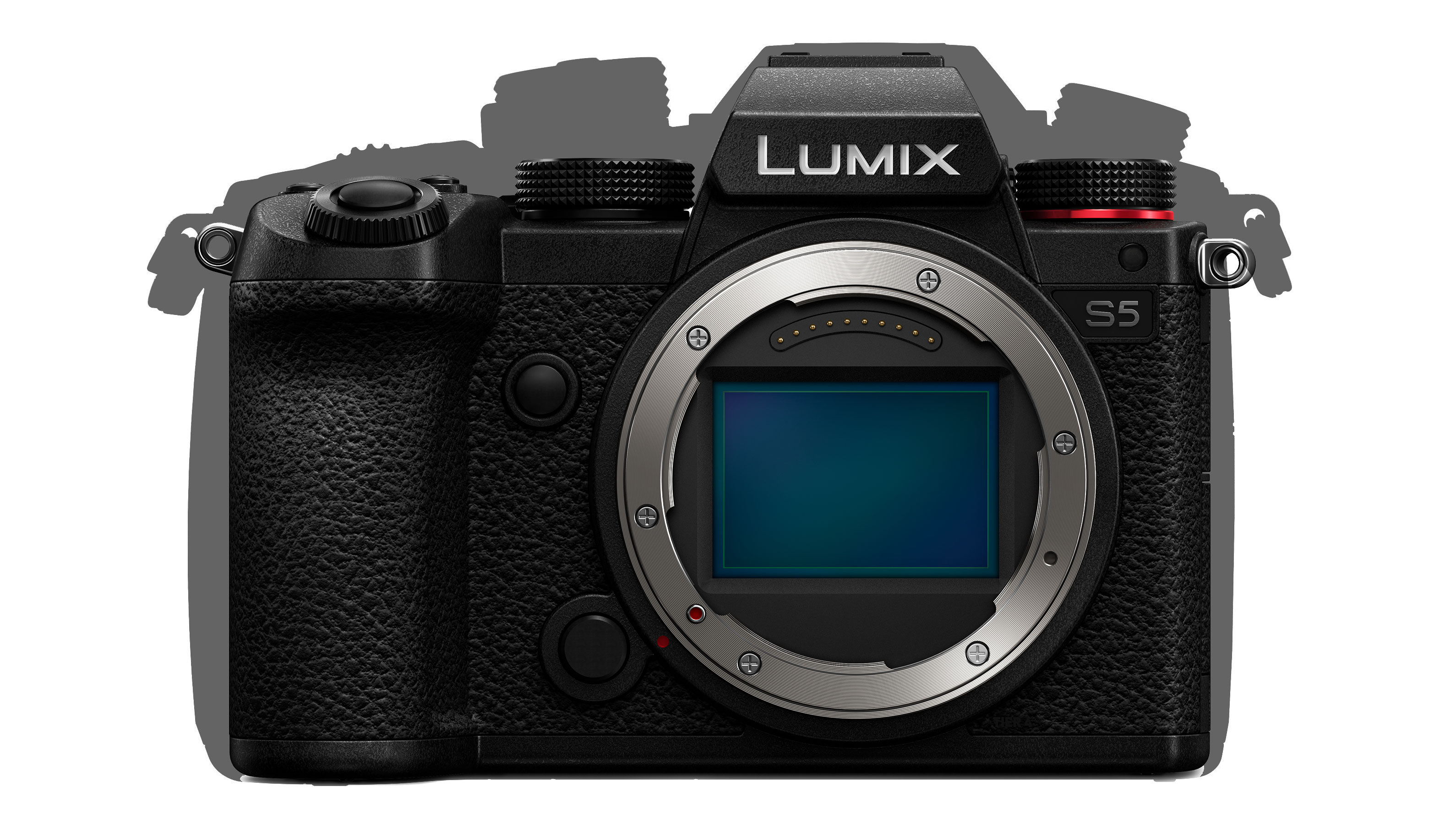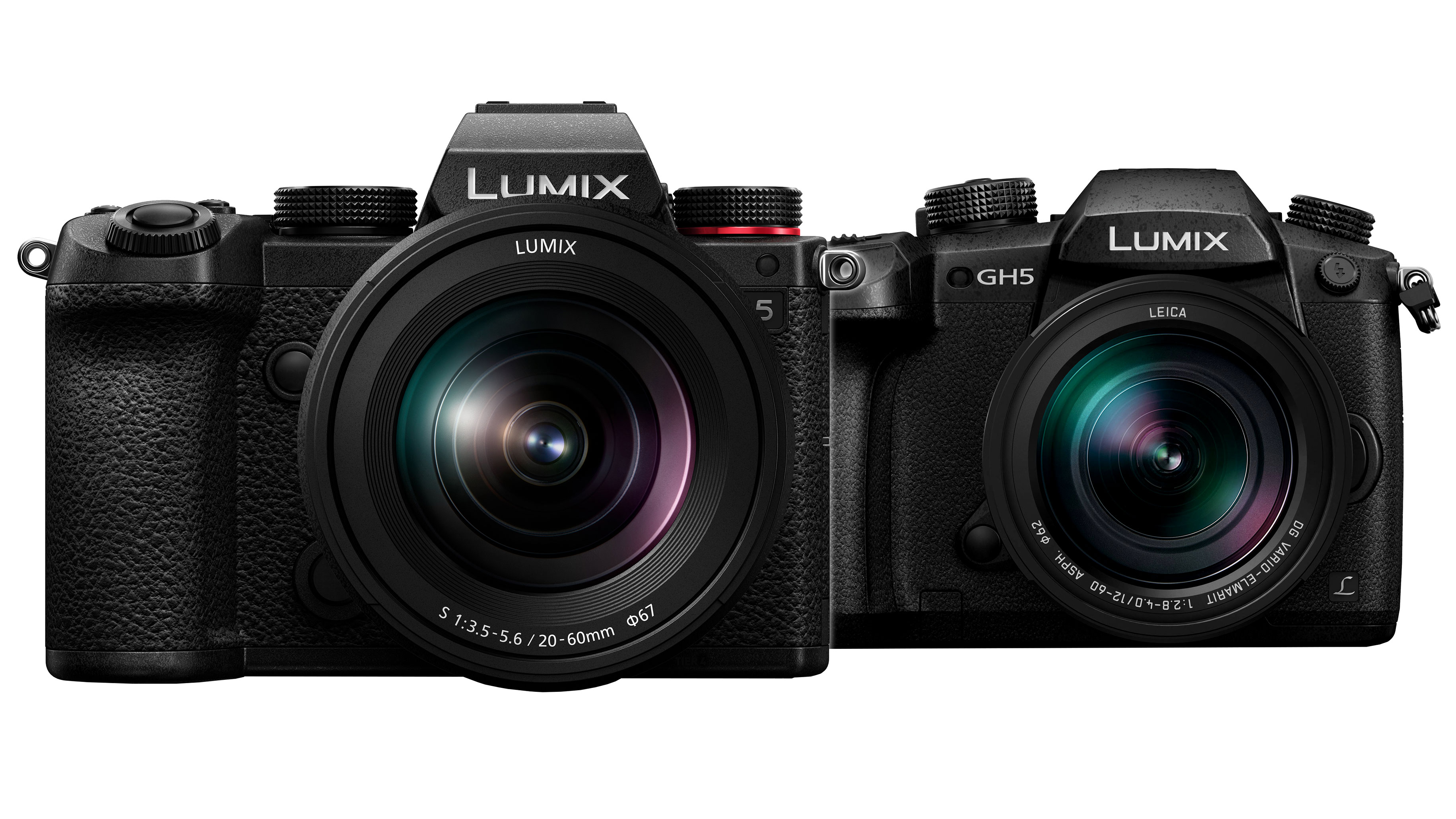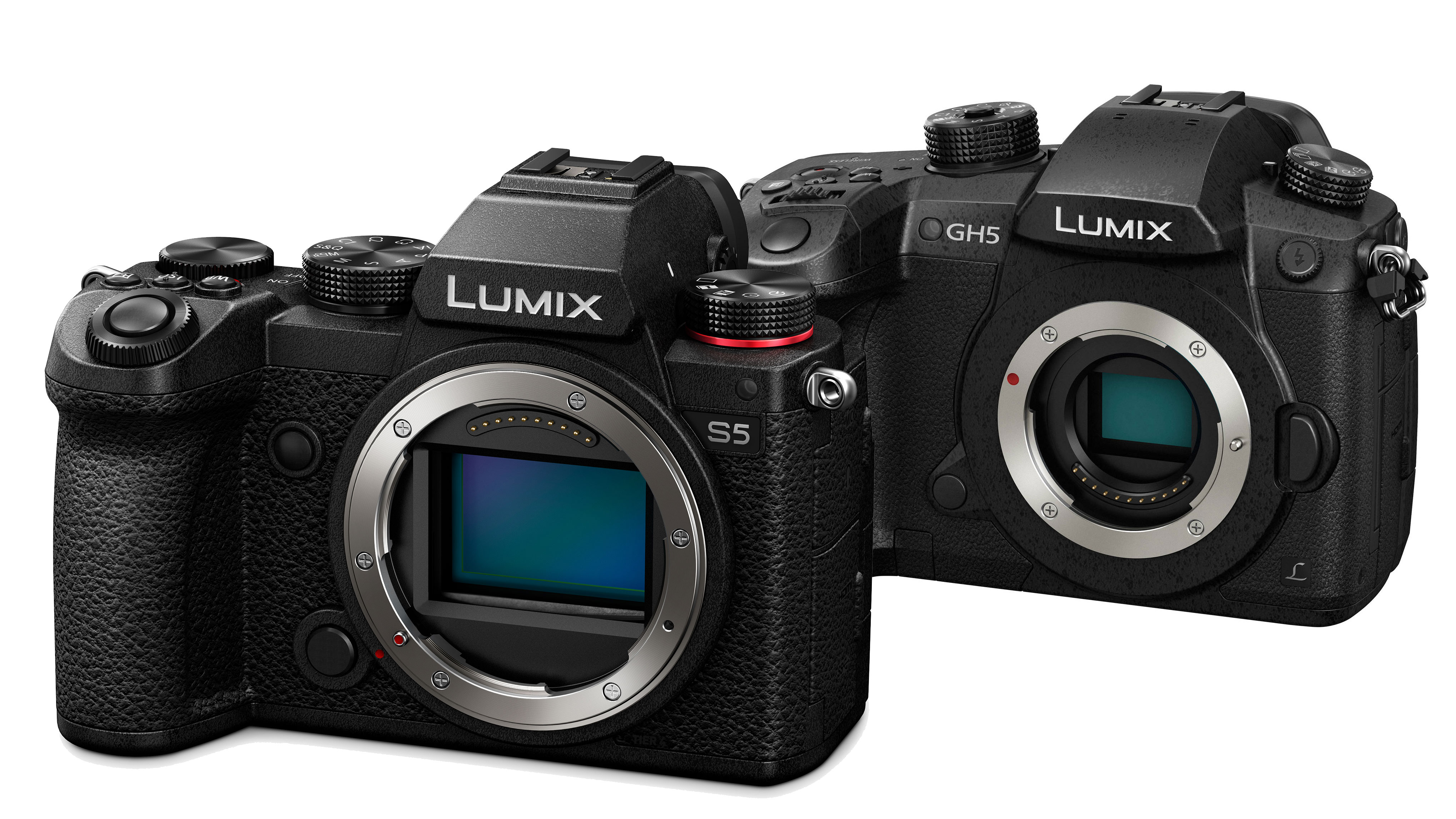Panasonic S5 vs GH5: which Lumix is best for video, vlogging and filmmaking?
Which of these hybrid video/stills cameras is best? Our Panasonic S5 vs GH5 guide will help you decide

This Panasonic S5 vs GH5 comparison pits an older, smaller format Lumix mirrorless camera against a much newer full frame model, but it's not quite the unequal battle it sounds.
Panasonic has a long track record of producing high-performance video/stills orientated mirrorless cameras, starting in the Micro Four Thirds market with its Lumix G models, headed up by the Lumix GH5, a camera launched way back in January 2017, but one which has gained tremendous respect amongst vloggers and filmmakers and is still regarded as one of the best 4K cameras for filmmakers, even now.
And Panasonic has now moved into the full frame mirrorless market, quickly building a compelling range of cameras. The latest is the Lumix S5, which is smaller even than the GH5, despite the larger sensor, and which incorporates many of the advanced cinema features of the larger and more expensive Lumix S models. The best Panasonic cameras now consist of a mix of Lumix G and Lumix S models.
This makes the Lumix GH5 and the new Panasonic Lumix S5 a close match in terms of price, size, video capabilities and intended users – so which is the best one to get, and why?
1 Sensor
Why you can trust Digital Camera World
• Panasonic Lumix GH5: MFT (17.3 x 13mm) Live MOS, 20.3MP
• Panasonic Lumix S5: Full frame (35.6 x 23.8mm) CMOS, 24.2MP
The first and most obvious difference between these two cameras is that the Lumix S5 has a full frame sensor and the GH5 has a much smaller Micro Four Thirds sensor that’s just a little more than one-quarter the size in terms of area. This has two effects
• The Lumix S5 will give shallower depth of field through using longer focal length lenses for the same angle of view.
• You can expect the Lumix S5 to offer better low-light/high-ISO Image quality.
2 Lenses
• Panasonic Lumix GH5: Micro Four Thirds
• Panasonic Lumix S5: L-mount
MFT lenses are smaller, lighter, cheaper and available in a greater variety of types. The size and weight could prove a key advantage for filmmakers who need to travel light. The range of L-mount lenses available for the Lumix S5 is growing rapidly, but these lenses are likely to remain more expensive, as well as being larger and heavier.
3 Max video resolution
• Panasonic Lumix GH5: C4K/4K UHD
• Panasonic Lumix S5: 4K UHD (C4K and 5.9K external to follow via firmware)
Both of these cameras can shoot 4K UHD video. The Lumix GH5 also shoots the slightly wider C4K format. However, the Lumix S5 will receive a firmware update by the end of 2020 which will allow C4K capture and 5.9K raw capture to an external Atomos Ninja V recorder.
4 Max frame rates
• Panasonic Lumix GH5: 4K UHD 60p, FHD 1080 60p
• Panasonic Lumix S5: 4K UHD 60p (APS-C crop), 30p (no crop), FHD 1080 60p
Both cameras can capture 4K UHD at up to 60p and full HD video at up to 60p, but the Lumix S5 does need to drop back to an APS-C pixel-by-pixel crop mode for 4K 60p capture.
5 Full width/crop capture
• Panasonic Lumix GH5: Uncropped
• Panasonic Lumix S5: APS-C crop for 4K 60p
As explained above, both cameras offer full width video capture, but the processing demands of the 4K 60p frame mean mean that the Lumix S5 cannot record full width video at this setting and swaps to an APS-C crop mode.
6 Compression
• Panasonic Lumix GH5: All-I, Long GOP
• Panasonic Lumix S5: Long GOP
The Lumix GH5 offers All-I compression in its best-quality modes, where individual frames are compressed, but each frame is complete. It also offers Long GOP compression for smaller file sizes/higher frame rates, where both intra-frame and inter-frame compression is used. The Lumix S5 shoots with Long GOP compression only. All-I gives the best theoretical quality, but is not always practical. Long GOP is likely to be perfectly adequate for all but the most demanding uses.
7 Max bitrate
• Panasonic Lumix GH5: 400Mbps
• Panasonic Lumix S5: 200Mbps
Bitrate is not an important specification in itself, but it does give a broad indication of the cameras maximum quality capture and general processing ‘muscle’. With a maximum bitrate of 400Mbps, the GH5 offers the best quality capture, but many would argue that’s easily offset by the Lumix S5’s larger sensor.
8 Color sampling
• Panasonic Lumix GH5: 4:2:2, 4:2:0
• Panasonic Lumix S5: 4:2:2, 4:2:0
Both cameras can capture 4:2:2 video internally, which is still quite rare amongst 4K mirrorless cameras, even now, and 4:2:0 is also available for smaller files or when outright quality is not essential. The sampling method is not the only factor in video, but one of many, including compression and bit depth, that go towards the final result.
9 Bit depth
• Panasonic Lumix GH5: 10-bit, 8-bit
• Panasonic Lumix S5: 10-bit, 8-bit
Both cameras can capture 10-bit video internally, which is also relatively uncommon. The difference between 8-bit and 10-bit video won’t be obvious if the video is used unedited, but becomes important if it’s going to be heavily edited (graded) later.

10 Log modes
• Panasonic Lumix GH5: Paid upgrade
• Panasonic Lumix S5: V-Log, V-Gamut
The Lumix S5 has Panasonic V-Log and V-Gamut installed as standard, but with the GH5 you have to buy a firmware upgrade to add Panasonic’s V-Log L mode. If you decide this is essential, it will add around $100 to the price of the GH5.
11 Recording time
• Panasonic Lumix GH5: Unlimited (Panasonic quotes no limits)
• Panasonic Lumix S5: 30 mins, unlimited for 4K UHD 4:2:0 8-bit
Panasonic does not quote recording limits for the GH5, and says that the Lumix S5 also offers no 4K recording time limit – but only for 4K UHD at 30p 4:2:0 8-bit capture. There is a 30-minute recording limit for 4K UHD 30p 4:2:2 10-bit capture, or for 4K 60p capture.
12 Viewfinder
• Panasonic Lumix GH5: OLED, 3,680k dots, 0.76x magnification
• Panasonic Lumix S5: OLED, 2,360k dots, 0.74x magnification
Interestingly, despite having a smaller format sensor, the GH5 actually has a rather better EVF than the Lumix S5. The magnification is very slightly higher and it has 50% greater resolution.
13 Rear screen
• Panasonic Lumix GH5: 3.2-inch vari-angle touchscreen, 1,620k dots
• Panasonic Lumix S5: 3-inch vari-angle touchscreen, 1,840k dots
Both cameras have vari-angle rear screens, and with little to choose between them. The Lumix S5 screen has slightly higher resolution, but the GH5’s is a little larger.
14 Memory
• Panasonic Lumix GH5: 2x SD/SDHC/SDXC, UHS-II
• Panasonic Lumix S5: 2x SD/SDHC/SDXC, UHS-1/UHS-II
Both cameras have two SD/SDHC/SDXC card slots, but while the GH5’s slots are both UHS-II compatible, only one of the slots on the Lumix S5 is UHS-II. This will be an annoyance to videographers who like to use the second slot as a live backup, or anyone who likes to use paired memory cards.
15 Battery life
• Panasonic Lumix GH5: 410/400 shots (rear screen/EVF)
• Panasonic Lumix S5: 440/470 shots (rear screen/EVF)
Again, there’s very little difference here. The Lumix S5 has slightly longer battery life on paper, but it’s unlikely to be particularly noticeable in use.

16 Size and weight (body only)
• Panasonic Lumix GH5: 138.5 x 98.1 x 87.4mm, 725g
• Panasonic Lumix S5: 132.6 x 97.1 x 81.9mm, 714g
The Lumix GH5 has a smaller sensor but is in fact a little larger than the Lumix S5. The difference is just a few millimetres here and there, however, so while it’s visible it’s unlikely to make any practical difference.

Panasonic Lumix S5 vs Lumix GH5: Conclusion
The Lumix GH5 is now more than three years old and uses a smaller sensor than the Lumix S5. It’s also maintained its value, so that while it is the cheaper option, that’s probably not going to be the most important factor in choosing one of these two cameras.
The Lumix S5 does have a larger sensor, the promise of better quality in low light and more ‘cinematic’ depth of field. The GH5, however, has access to a wider range of smaller, cheaper and lighter lenses. Building a system will be cheaper, and it will be more portable too.
Old as it is, the GH5 has a couple of practical advantages. One is that it offers full-width capture in all modes, where the Lumix S5 has to swap to crop mode for 4K 60p capture. Another is that the GH5 has dual UHS-II card slots where the Lumix S5, oddly, has one UHS-I slot and one UHS-II.
On the other hand, the Lumix S5 has Panasonic V-Log built in, where it’s a paid-for upgrade on the GH5, and the Lumix S5 will also benefit from a firmware upgrade later in the year which will offer 5.9K raw capture over HDMI to an Atomos Ninja V recorder.
Beyond that, in the complex matrix of video resolutions, color sampling, bit-depths and frame rates, both cameras are quite evenly matched. The Lumix S5 offers a remarkable combination of power and value in the current full frame market, but the GH5 still has the specs, features and capabilities to meet it head-on, for video capture at least.
Read more:
• Best cameras for video
• Best Panasonic cameras
• Best Micro Four Thirds lenses
• Best vlogging cameras
• Best cinema cameras
• Best mirrorless cameras
The best camera deals, reviews, product advice, and unmissable photography news, direct to your inbox!

Rod is an independent photography journalist and editor, and a long-standing Digital Camera World contributor, having previously worked as DCW's Group Reviews editor. Before that he has been technique editor on N-Photo, Head of Testing for the photography division and Camera Channel editor on TechRadar, as well as contributing to many other publications. He has been writing about photography technique, photo editing and digital cameras since they first appeared, and before that began his career writing about film photography. He has used and reviewed practically every interchangeable lens camera launched in the past 20 years, from entry-level DSLRs to medium format cameras, together with lenses, tripods, gimbals, light meters, camera bags and more. Rod has his own camera gear blog at fotovolo.com but also writes about photo-editing applications and techniques at lifeafterphotoshop.com



